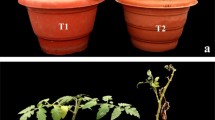Abstract
Several unsaturated aldehydes are produced from polyunsaturated fatty acids via the lipoxygenase pathway when soybean (Glycine max) plants are wounded mechanically or by pathogens. The effects of four of these aldehydes were examined on the growth of isolated fungal cultures ofColletotrichum truncatum, Rhizoctonia solani, andSclerotium rolfsii. (E)-2-Hexenal, (E)-2-nonenal, and (Z)-3-nonenal inhibited the growth ofR. solani andS. rolfsii at 35 μmol added per liter or greater when applied as volatiles, although higher levels were required for inhibition ofC. truncatum. (E)-4-Hydroxy-2-nonenal was the most inhibitory compound when applied directly in the growth medium, but it had the least effect as a volatile.
Similar content being viewed by others
References
Bostock, R.M., Yamamoto, H., Choi, D., Ricker, K.E., andWard, B.L. 1992. Rapid stimulation of 5-lipoxygenase activity in potato by the fungal elicitor arachidonic acid.Plant Physiol. 100:1448–1456.
Bradow, J.M. 1991. Relationships between chemical structure and inhibitory activity of C6 through C9 volatiles emitted by plant residues.J. Chem. Ecol. 17:2193–2212.
Deng, W., Hamilton-Kemp, T.R., Nielsen, M.T., Andersen, R.A., Collins, G.B., andHildebrand, D.F. 1993. Effects of six-carbon aldehydes and alcohols on bacterial proliferation.J. Agric. Food Chem. 41:506–510.
Esterbauer, H., Schaur, J.R., andZollner, H. 1991. Chemistry and biochemistry of 4-hydroxynonenal, malonaldehyde and related aldehydes.Free Radical Biol. Med. 11:81–128.
French, R.C. 1992. Volatile chemical germination stimulators of rust and other fungal spores.Mycologia 84:277–288.
Gardner, H.W. 1991. Recent investigations into the lipoxygenase pathway of plants.Biochim. Biophys. Acta 1084:221–239.
Gardner, H.W., andHamberg, M. 1993. Oxygenation of (3Z)-nonenal to (2E)-4-hydroxy-2- nonenal in the broad bean (Vicia faba L.).J. Biol. Chem. 268:6971–6977.
Gardner, H.W., Dornbos, D.L., Jr., andDesjardins, A.E. 1990. Hexanal, trans-2-hexenal, and trans-2-nonenal inhibit soybean,Glycine max, seed germination.J. Agric. Food Chem. 38:1316–1320.
Gardner, H.W., Weisleder, D., andPlattner, R.D. 1991. Hydroperoxide lyase and other hydroperoxide-metabolizing activity in tissues of soybean,Glycine max.Plant Physiol. 97:1059–1072.
Gardner, H.W., Bartelt, R.J., andWeisleder, D. 1992. A facile synthesis of 4-hydroxy-2(E) nonenal.Lipids 27:686–689.
Hamilton-Kemp, T.R., Loughrin, J.H., Archbold, D.D., Andersen, R.A., andHildebrand, D.F. 1991. Inhibition of pollen germination by volatile compounds including 2-hexenal and 3-hexenal.J. Agric. Food Chem. 39:952–956.
Hamilton-Kemp, T.R., Mccracken, C.T., Jr. Loughrin, J.H., Andersen, R.A., andHilde-Brand, D.F. 1992. Effects of some natural volatile compounds on the pathogenic fungiAlternaria alternata andBotrytis cinerea.J. Chem. Ecol. 18:1083–1091.
Hildebrand, D.F., Rodriguez, J.G., Legg, C.S., Brown, G.C., andBookjans, G. 1989. The effects of wounding and mite infestation on soybean leaf lipoxygenase levels.Z. Naturforsch. 44c:655–659.
Hora, T.S., andBaker, R. 1970. Volatile factor in soil fungistasis.Nature 225:1071–1072.
Liebman, J.A., andEpstein, L. 1992. Activity of fungistatic compounds from soil.Phytopathology 82:147–153.
Misaghi, I.J. 1982. Physiology and Biochemistry of Plant-Pathogen Interactions, Plenum Press, New York, 287 pp.
Ohta, H., Shida, K., Peng, Y.-L., Furusawa, I., Shishiyama, J., Aibara, S., andMorita, Y. 1991. A lipoxygenase pathway is activated in rice after infection with the rice blast fungusMagnaporthe grisea.Plant Physiol. 97:94–98.
Vaughn, S.F., andLulai, E.C. 1992. Further evidence that lipoxygenase activity is required for arachidonic acid-elicited hypersensitivity in potato callus cultures.Plant Sci. 84:91–98.
Yamamoto, H., andTani, T. 1986. Possible involvement of lipoxygenase in the mechanism of resistance of oats to Puccinia coronata avenae.J. Phytopathol. 116:329–337.
Author information
Authors and Affiliations
Additional information
Mention of firms or products does not imply endorsement by the U.S. Department of Agriculture over other firms or products not mentioned.
Rights and permissions
About this article
Cite this article
Vaughn, S.F., Gardner, H.W. Lipoxygenase-derived aldehydes inhibit fungi pathogenic on soybean. J Chem Ecol 19, 2337–2345 (1993). https://doi.org/10.1007/BF00979668
Received:
Accepted:
Issue Date:
DOI: https://doi.org/10.1007/BF00979668




